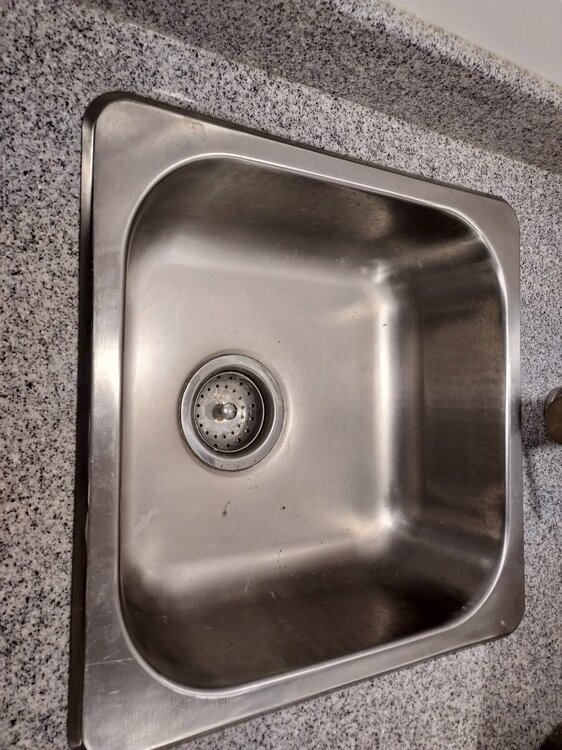-
Posts
945 -
Joined
-
Last visited
-
Days Won
18
Everything posted by Rivernerd
-

1UP Quik Rack With Oliver Standard 1.25" Receiver
Rivernerd replied to Rivernerd's topic in Mechanical & Technical Tips
Mossemi: Thanks for the "heads up." Here is my quandry: The Oliver bumper hitch has a 1.25" receiver, but the only 1UP bike racks rated for RV/travel trailer use (like the SD (Super Duty) require a 2" receiver. Yet, I note threads indicating that some Oliver Elite II owners use 1UP racks with the Oliver bumper hitch. Can anyone on this forum provide a solution? -
I have reviewed various forum posts addressing use of a 1UP bike rack with an Oliver Elite II rear hitch receiver. The threads I found discuss modifying the Oliver standard 1.25" receiver to accept a 1UP bike rack with a 2" shank, but I could find no threads addressing use of a 1UP Quik Rack (which comes compatible with a 1.25" receiver) in a standard Oliver 1.25" rear hitch receiver. Does anyone use a 1UP Quik Rack (which works for me because I only need to carry one bike) with the standard Oliver 1.25" rear hitch receiver? If so, what is your experience?
-
Thanks! Boise is the closest metro area to our rural home in central Idaho, so we are among the beneficiaries of your thoughtful post. Great to know!
-
We opted for the manual door lock in our 2022 Elite II based on reports on this forum of folks getting locked in or out of their Olivers by failed RV Lock units. No issues with key duplication. We keep a spare Oliver door key in a compartment in our tow vehicle. Low tech, but so far, no issues.
-

Incredible noisy AC, any solutions in sight.
Rivernerd replied to Nick and Linda Stratigakis's topic in General Discussion
We also own a 2022 Elite II, Hull #1291. Having read too many posts on this forum about the Demonic AC unit sounding like a jet taking off, and that Oliver was making the much quieter Truma AC unit available on 2023 models, we opted to postpone our delivery from September to November of 2022 to get a Truma. We paid a premium for the upgrade, but we have not regretted our choice. Although expensive, in your shoes, I would schedule an appointment with the closest Oliver dealer to swap the Demonic for a Truma. If you have strong handyman skills, you can consider a DIY install. with one of the brands referenced in jd1923's post above. There are informative threads on this forum with detailed "how to" instructions. And, please update your footer to include your Hull #, tow vehicle and other important data, like you see on the above posts. -
For what it's worth, we "bit" last year on an "upgrade" offer from a Levelmate Pro to a Levelmate Max, because of battery issues with the Levelmate Pro. But the Levelmate Max has unreliable connectivity and the software is "buggy". It became so frustrating we reverted to 2-person campsite setup, with a torpedo level. Having now used both the Levelmate Pro and the Levelmate Max, we wish we had instead purchased the Beech Lane (as suggested by Patriot, above).
-

2026 YM Oliver awning style windows and other changes
Rivernerd replied to Patriot's topic in Ollie Modifications
No. They are not rust bumps. They are small black, concave pits. I know of no way to address them other than replacing the sink. Do you think barkeeper's friend would help? -

2026 YM Oliver awning style windows and other changes
Rivernerd replied to Patriot's topic in Ollie Modifications
Are the sliding windows Oliver has used for years no longer available? -

2026 YM Oliver awning style windows and other changes
Rivernerd replied to Patriot's topic in Ollie Modifications
We left a bottle of Dawn dish soap, stuffed in a plastic shopping bag, in the sink while on the road. The soap bottle leaked, and we didn't catch it before winter storage. We didn't know that Dawn can be corrosive, if allowed to sit fully concentrated on steel for too long. Lesson learned! The pitting is just unsightly enough to land sink replacement on my "some day" to-do list, maybe in the winter. Does anyone know where to source a replacement galley sink? My preliminary research suggests it is not a stock size available from etrailer or Lippert. I submitted a "low priority" ticket to Oliver, but they have not yet gotten back to me. -

2026 YM Oliver awning style windows and other changes
Rivernerd replied to Patriot's topic in Ollie Modifications
Looks great, but much more expensive to replace than the stainless version in the event of damage. The stainless galley sink in our Hull #1291 (2022) is pitted, so replacing it is on my "to do" list, after our fall extended trip. -

Cannot pump water from fresh tank
Rivernerd replied to Wayfinder's topic in Mechanical & Technical Tips
The fresh water pump in my 2022 Elite II, Hull #1091, would not pump water from a full fresh water tank after sitting through the winter. Several attempts, no water, just a whining sound, Before I tried John Davies "prime the pump" suggestion above, I removed the filter from the inlet side of the pump. It was full of brown slime! A thorough wash of the filter housing and mesh filter enabled the pump to then work as designed, pumping water from the fresh tank to the sinks and toilet. Lesson learned: check, and clean, the pump filter annually after de-winterizing. -
In addition to Galway Girl's important questions: How are you measuring charge rate and charge level? Are you using the Lithionics app, the Victron Connect app, the SeeLevel gauge next to the pantry or a multimeter? Also, are you charging using the solar panels? This additional info will help us help you. Rivernerd
-
I added 4 vents, including two (top and bottom) in the closet. See my post from January 31, 2023 above in this thread.
-

Two Quick Stabilizer Jack Questions
Rivernerd replied to Tony and Rhonda's topic in Mechanical & Technical Tips
That's not an unusual amount of rust for an 8-year-old trailer that lives in Kentucky. I would apply Rust Mort to the jack foot plate, then a metal primer, then black spray paint. I would cut off the old caulk, then apply butyl caulk at the jack penetration point. -

Which jack do you carry on your trips ?
Rivernerd replied to Tideline77's topic in Mechanical & Technical Tips
I bought a Safe Jack 6-Ton RV Bottle Jack Kit before we picked up our Hull #1291 in Hohenwald. I carry it in our tow vehicle whenever towing our Elite II. https://safejacks.com/products/6-ton-rv-jack-kitsrsltid=AfmBOopBQgN9ggcFSaXvjvqjQnAZ-QT8Yj9wNnfyNFYXMuqHtDAhhDW6 That said, I wish I had known to buy one or two of the 3-ton Unijacks referenced by Galway Girl above. I believe they are better designed for roadside repair of an Elite II. They take up more cargo space in the tow vehicle, but I would gladly give up that extra space for the jackstand feature. It is what I would buy if I were buying now. -
I agree, but am compelled to add: "And, how much risk you are comfortable taking." We use an Anderson WDH because the owners manual for our 2019 Tundra tow vehicle requires a WDH when towing over 5K lbs. This requirement is not enforced by police, but by insurance companies and courts should you ever be involved in a traffic accident while towing. As a retired attorney whose practice included defense of serious accident cases, I consider the Anderson WDH "cheap insurance" against the risk that I will be found at fault because I ignored Toyota's WDH requirement.
-
The tow vehicle suspension modifications are not legally required, but they add some stability, particularly with "porpoising" when going over a dip in the road. I note your tow vehicle is a 2023 Tundra. Our tow vehicle is a 2019 Tundra. I installed an Anderson weight distribution hitch when we picked up our 2022 Elite II in Hohenwald, because our Toyota owners manual requires one when towing over 5K lbs. I am glad I did. In 2023, after towing our Elite II about 3000 miles, I added Airlift Loadlifter 5000 air bags to the Tundra, based on some informative threads on this forum. The air bags have added the small margin of stability referenced above when towing our Elite II. To me, that added margin of control, and safety, has been worth the expense of both $$$$ and my time. The Anderson chains must be tight to function properly. Tight does not equal "over-stressed." Also, suspension mods like air bags do not increase your payload capacity. But I feel more control, and therefore somewhat safer, when towing our Elite II with the air bags than I did before they were installed.
-

How many different KEY's do you have?
Rivernerd replied to Dave and Kimberly's topic in General Discussion
3. Although our Elite II entry door is keyed (because keypad durability got poor reviews on this forum), we still have just three: (1) our Tundra key; (2) the key to the Oliver and (3) the key to the locking topper/canopy on the Tundra. How? Anticipating the "high school janitor" issue highlighted here, the locks for our drawbar receiver, the two locks that secure our trailer coupler when the Tundra is disconnected, and even for the cable that secures the Power Watchdog to the campground power post, are 4-digit "keyless" combination locks, all set to the same combination. https://www.extremeterrain.com/trimax-locks-bronco-1-2-inch-resettable-combination-receiver-lock-mag125.html?utm_content=XT Towing - Hitches|Trimax Locks&T5_Var4=FB37443&utm_campaign=XT+General+No+Vehicle+High+LTVMiddle&dialogtech=ppc&utm_source=google-pla&utm_medium=shopping&T5_Var2=shopping&gclsrc=aw.ds&gad_source=1&gad_campaignid=1059055562&gclid=EAIaIQobChMIq_ebhu-CjgMV4IbuAR0dFy0QEAQYAyABEgJKqvD_BwE https://www.amazon.com/HQPASFY-Trailer-Combination-Coupler-Couplers/dp/B0CYCDC2QW?source=ps-sl-shoppingads-lpcontext&ref_=fplfs&smid=AIEVNSJ0YNP6V&gQT=1&th=1 https://www.amazon.com/Antivanl-Trailer-Bulldog-Couplers-Stainless/dp/B0CYLK7KLG/ref=asc_df_B0CYLK7KLG?mcid=682ffb9c894037ad9156a29340e8450b&hvocijid=2600007127687710942-B0CYLK7KLG-&hvexpln=73&tag=hyprod-20&linkCode=df0&hvadid=721245378154&hvpos=&hvnetw=g&hvrand=2600007127687710942&hvpone=&hvptwo=&hvqmt=&hvdev=c&hvdvcmdl=&hvlocint=&hvlocphy=2840&hvtargid=pla-2281435177578&psc=1 https://www.amazon.com/NBYT-Combined-Suitable-lockers-wardrobes/dp/B0BX5DK8D7/ref=sr_1_1_sspa?dib=eyJ2IjoiMSJ9.JQVu21JT9tdq19P6TSFQQbcJAj1qCKfMOjBmTWWMuRmwQbuA7vgjJuNyKu4JZIgyITuPS1QSYT5D5C84sZPsoOwEbbBWWl7hVg764V_pkNNtXqJ13DQm0pXR-uB1WuywIj2jvleQQrmKw0x9JyNrhxLT5HC5ifxWRcair5wSlSVuHX5m9yai9khKqqw9EbEHgNShetAFnfWILTHMfDZD5sIo1YiYro-l1FnavFs00BPCx_tmHbJYvD6dYJgcrQ_Q8V0Z-F0-uCq-oNY5-Wd6pkGitATB5ms3kU_SChgXbjk.8nf1pFQiE4e-riSPYwqc_UnZDpHcl-eORn-jMdmUsx0&dib_tag=se&keywords=combination%2Bcable%2Block&qid=1750521430&sr=8-1-spons&sp_csd=d2lkZ2V0TmFtZT1zcF9hdGY&th=1 -

Can I tow an Oliver LE2 with a 2006 SR5 Tundra Double Cab?
Rivernerd replied to Dirt Duff's topic in Towing an Oliver
My mistake. My 2019 Tundra has the V8 5.7L engine, not a 4.7L. The 5.7L has enough power to pull the Elite II up the mountains of the Pacific Northwest. -

Can I tow an Oliver LE2 with a 2006 SR5 Tundra Double Cab?
Rivernerd replied to Dirt Duff's topic in Towing an Oliver
We struggled with the same question when we bought our Elite II in 2022. We ultimately chose to stick with the Gen. 2 (2019) Tundra 4.7L Double Cab we already owned. We have towed our 2022 Elite II with that 2019 Tundra with the 4.7L engine, a transmission oil cooler and an Andersen weight distribution hitch, without trouble. We live in Idaho, and have towed it over mountain passes in the Pacific Northwest many times. I know that some on this forum will disagree, but my experience is that at least Gen. 2 Tundras are not true "1/2 ton" pickups. They fall somewhere between the 1/2 ton and 3/4 ton pickups offered by their competitors, and so are up to the task of towing an Elite II with an Andersen WD hitch. Your Gen. 1 Tundra may be different. Your specific door sticker controls over the more generic owners manual. The door sticker on our Tundra also reads 1421 lbs. payload capacity. We initially towed our Elite II from Hohenwald to central Idaho without airbags. The addition of airbags helped reduce jounce, so I would recommend them. We have not upgraded the already substantial 4-wheel disc brakes on the Tundra, yet with the gain properly set on the brake controller, the Elite II braking system has enabled us to safely make a couple of panic stops (such as for a deer in the road) without incident. -

Rear Electric Stabilizer Jack adjustment - help?
Rivernerd replied to tallmandan's topic in Mechanical & Technical Tips
-

Rear Electric Stabilizer Jack adjustment - help?
Rivernerd replied to tallmandan's topic in Mechanical & Technical Tips
This is not the response I have come to expect from OTT when a manufacturing defect comes to light. Hmmm... -

2" 1UP hitch post doesn't fit 2" Oliver bike receiver 😵
Rivernerd replied to GlacierGirl's topic in General Discussion
The "safe harbor" would be to file down the steel 1UP shank, to avoid reducing the strength of the (much softer) aluminum 2" receiver. As it seems you do not already own a grinder with a metal grinding wheel, I recommend you buy an inexpensive 4-1/2" grinder from Harbor Freight ($15), along with a steel grinding wheel ($2). That $17 investment will make quick work of grinding down the leading edge of the steel 1UP shank. Wear eye protection! https://www.harborfreight.com/43-amp-4-12-in-angle-grinder-with-slide-switch-58089.html?utm_source=google&utm_medium=cpc&utm_campaign=22297023987&campaignid=22297023987&utm_content=174581963486&adsetid=174581963486&product=58089&store=54&gad_source=1&gad_campaignid=22297023987&gbraid=0AAAAADAHb4fYAJW562_ET-7xFgrqI0OTz&gclid=CjwKCAjw56DBBhAkEiwAaFsG-s7clZOjXr5HmLObHpLJU78M9ai56THL1WHHf7T8vdcqRRwuMLx5rBoCoVEQAvD_BwE https://www.harborfreight.com/4-12-in-24-grit-metal-grinding-wheel-64025.html Good luck! -

Can not use electrical outlets with GFCI; normal?
Rivernerd replied to Gliddenwoods's topic in Mechanical & Technical Tips
I plug our Elite II into a 120V GFCI protected receptacle in my garage (current code requires all garage receptacles to be GFCI protected) when packing for a trip. With a 20 amp to 30 amp adapter, connected to the Oliver's 30A input, it works fine. FWIW, when storing our Elite II, it is connected to a dedicated 30A receptacle in our storage shed. I always use 30A receptacles at campgrounds, again with no issues, unless the campground power supply is bad.








